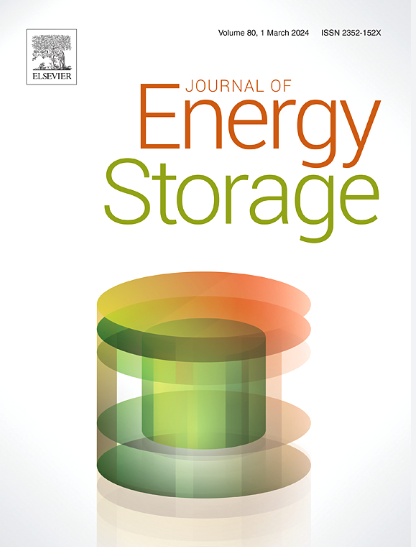Cotton cloth-derived porous carbon skeleton with graphite layer for enhancing the thermal conductivity of energy storage phase change materials
IF 8.9
2区 工程技术
Q1 ENERGY & FUELS
引用次数: 0
Abstract
Phase change materials (PCMs) have advantageous energy storage capacity, but their poor shape stability and low thermal conductivity restrict their practical applications in the field of energy storage. In this study, the graphite flakes were adhered to the waste cotton strips, and the cotton strips were rolled up layer by layer to form a cotton-derived porous carbon skeleton after a high temperature carbonization. The graphite flake and the carbonized cotton cloth were connected to each other to forming a good heat conduction path. Composite phase change materials (CPCMs) were successfully prepared by vacuum impregnation of phase change material stearic acid (SA). The results showed that the thermal conductivity of CPCMs can be greatly improved in terms of forming the cotton-derived porous carbon skeleton. When the content of skeleton filler was 26.46 wt%, the normal thermal conductivity of the prepared CPCMs reached 5.51 W/(m·K), which was 21.19 times higher than that of pure stearic acid, along with a photothermal conversion efficiency of 82.6 % and phase change enthalpy of 148.99 J/g. Moreover, the CPCMs demonstrated great shape stability, obvious anti-leakage characteristic and advanced photothermal conversion capacity. The above results show that the CPCMs prepared by this method have broad application prospects in the field of solar thermal storage and thermal management.
用于提高储能相变材料导热性的石墨层棉衍生多孔碳骨架
相变材料(PCMs)具有良好的储能能力,但其形状稳定性差,导热系数低,限制了其在储能领域的实际应用。在本研究中,将石墨薄片粘附在废棉条上,将废棉条逐层卷起,经高温碳化后形成棉源多孔碳骨架。将石墨片与炭化棉布相互连接,形成良好的热传导路径。采用真空浸渍硬脂酸法制备了复合相变材料(CPCMs)。结果表明,cpcm的热导率在形成棉源多孔碳骨架方面可以得到很大的提高。当骨架填料含量为26.46 wt%时,制备的CPCMs的正常热导率达到5.51 W/(m·K),是纯硬脂酸的21.19倍,光热转换效率为82.6%,相变焓为148.99 J/g。此外,cpcm具有良好的形状稳定性、明显的防泄漏特性和先进的光热转换能力。以上结果表明,该方法制备的cpcm在太阳能蓄热与热管理领域具有广阔的应用前景。
本文章由计算机程序翻译,如有差异,请以英文原文为准。
求助全文
约1分钟内获得全文
求助全文
来源期刊

Journal of energy storage
Energy-Renewable Energy, Sustainability and the Environment
CiteScore
11.80
自引率
24.50%
发文量
2262
审稿时长
69 days
期刊介绍:
Journal of energy storage focusses on all aspects of energy storage, in particular systems integration, electric grid integration, modelling and analysis, novel energy storage technologies, sizing and management strategies, business models for operation of storage systems and energy storage developments worldwide.
 求助内容:
求助内容: 应助结果提醒方式:
应助结果提醒方式:


